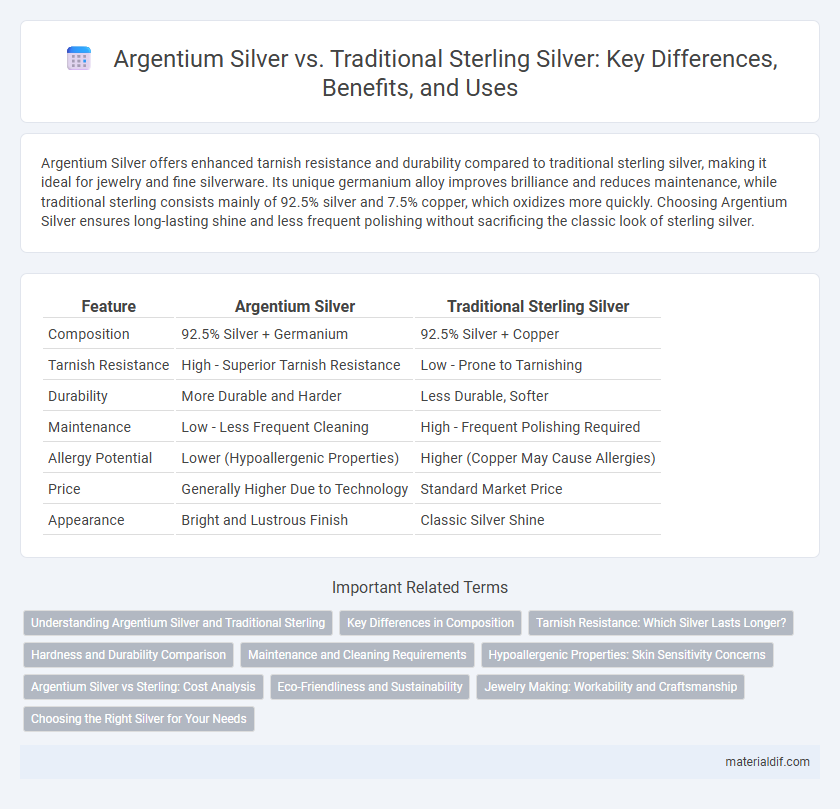Argentium Silver offers enhanced tarnish resistance and durability compared to traditional sterling silver, making it ideal for jewelry and fine silverware. Its unique germanium alloy improves brilliance and reduces maintenance, while traditional sterling consists mainly of 92.5% silver and 7.5% copper, which oxidizes more quickly. Choosing Argentium Silver ensures long-lasting shine and less frequent polishing without sacrificing the classic look of sterling silver.
Table of Comparison
| Feature | Argentium Silver | Traditional Sterling Silver |
|---|---|---|
| Composition | 92.5% Silver + Germanium | 92.5% Silver + Copper |
| Tarnish Resistance | High - Superior Tarnish Resistance | Low - Prone to Tarnishing |
| Durability | More Durable and Harder | Less Durable, Softer |
| Maintenance | Low - Less Frequent Cleaning | High - Frequent Polishing Required |
| Allergy Potential | Lower (Hypoallergenic Properties) | Higher (Copper May Cause Allergies) |
| Price | Generally Higher Due to Technology | Standard Market Price |
| Appearance | Bright and Lustrous Finish | Classic Silver Shine |
Understanding Argentium Silver and Traditional Sterling
Argentium Silver is a modern alloy that contains a minimum of 92.5% silver, like traditional sterling, but replaces some copper with germanium to enhance tarnish resistance and durability. Traditional sterling silver consists of 92.5% pure silver and 7.5% copper, which can tarnish quickly and require frequent polishing. Argentium's unique composition offers superior shine, increased hardness, and improved hypoallergenic properties compared to traditional sterling silver.
Key Differences in Composition
Argentium Silver contains a minimum of 92.5% silver, with the primary difference being the addition of germanium, typically around 1-2%, which replaces some of the copper found in traditional sterling silver that has 7.5% copper alloy. This germanium inclusion enhances tarnish resistance, reduces firescale, and improves overall durability compared to the conventional sterling silver composition. Traditional sterling silver's higher copper content makes it more prone to oxidation and tarnishing, requiring more frequent maintenance.
Tarnish Resistance: Which Silver Lasts Longer?
Argentium Silver offers superior tarnish resistance compared to traditional sterling silver due to its unique germanium alloy, which forms a protective oxide layer preventing discoloration. Traditional sterling silver, composed of 92.5% silver and 7.5% copper, tends to tarnish faster as copper oxidizes over time. This enhanced durability makes Argentium Silver ideal for jewelry and silverware that maintains its shine longer with minimal maintenance.
Hardness and Durability Comparison
Argentium Silver boasts superior hardness compared to traditional sterling silver, typically measuring Mohs hardness between 3.5 and 4, while sterling silver averages around 2.5 to 3. The enhanced hardness of Argentium results from its unique alloy composition, which includes germanium, significantly improving scratch resistance and durability. This makes Argentium Silver more suitable for everyday wear and jewelry pieces prone to frequent handling and abrasion.
Maintenance and Cleaning Requirements
Argentium Silver offers superior tarnish resistance compared to traditional sterling silver, significantly reducing the frequency of cleaning and maintenance. Its unique alloy composition includes germanium, which forms a protective oxide layer, preventing oxidation and simplifying upkeep. Traditional sterling silver requires regular polishing with anti-tarnish cloths or solutions to maintain its shine, making Argentium Silver a more practical choice for low-maintenance jewelry.
Hypoallergenic Properties: Skin Sensitivity Concerns
Argentium Silver contains a higher purity level of silver and replaces nickel with germanium, significantly reducing the risk of allergic reactions compared to traditional sterling silver, which often includes nickel, a common skin irritant. This hypoallergenic composition makes Argentium Silver an ideal choice for individuals with sensitive skin or metal allergies. Its enhanced tarnish resistance further minimizes skin discoloration and irritation, ensuring a more comfortable wearing experience.
Argentium Silver vs Sterling: Cost Analysis
Argentium Silver typically costs 10-20% more than traditional Sterling Silver due to its higher purity and added benefits such as enhanced tarnish resistance. The manufacturing process of Argentium involves germanium alloying, which increases material expenses but reduces long-term maintenance costs compared to Sterling's susceptibility to tarnish. While initial investment in Argentium is higher, its durability and lower upkeep can result in better cost efficiency over time for jewelry makers and consumers.
Eco-Friendliness and Sustainability
Argentium silver outperforms traditional sterling silver in eco-friendliness due to its higher resistance to tarnish, reducing the need for harsh chemical cleaners that harm the environment. Its composition includes recycled silver and germanium, enhancing sustainability by minimizing mining impact and energy consumption during production. The alloy's longer lifespan and recyclability contribute to a significant reduction in resource waste compared to conventional sterling silver.
Jewelry Making: Workability and Craftsmanship
Argentium Silver, containing a higher percentage of pure silver and germanium, offers superior tarnish resistance and enhanced malleability compared to traditional sterling silver, which is an alloy of 92.5% silver and 7.5% copper. Jewelers favor Argentium for its ease in soldering, reduced firescale, and ability to hold intricate details, improving craftsmanship quality. Traditional sterling silver remains popular for its classic luster and hardness but requires more maintenance and careful handling during complex jewelry making.
Choosing the Right Silver for Your Needs
Argentium silver offers enhanced tarnish resistance and increased durability compared to traditional sterling silver, making it ideal for jewelry and items exposed to frequent wear. Traditional sterling silver, composed of 92.5% pure silver and 7.5% copper, provides a classic look with time-tested properties but requires more maintenance to prevent tarnish. Selecting between Argentium and traditional sterling depends on your priorities for longevity, ease of care, and aesthetic preference in silver items.
Argentium Silver vs Traditional Sterling Infographic

 materialdif.com
materialdif.com